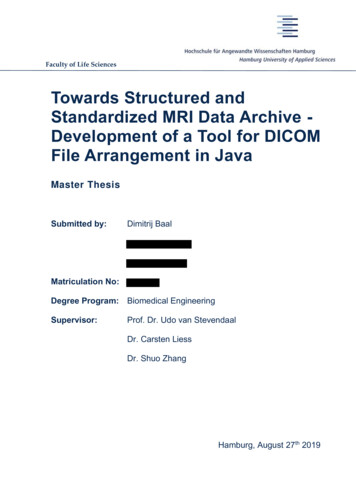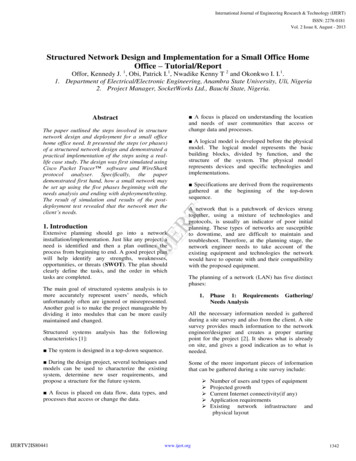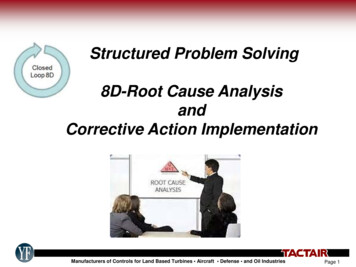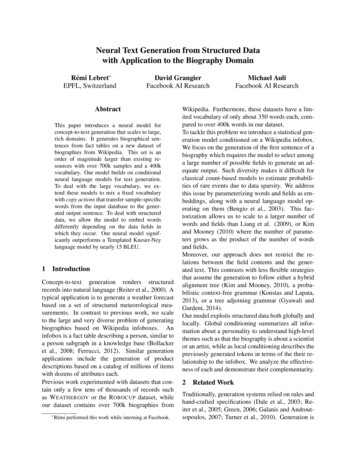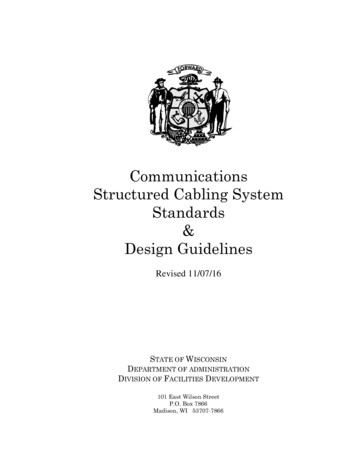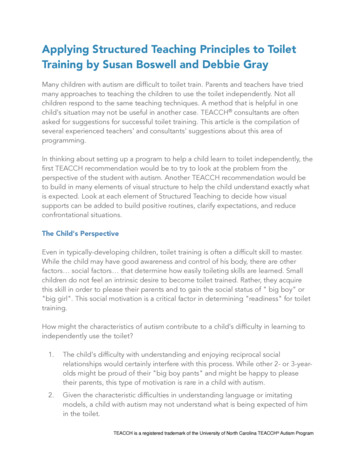
Transcription
Applying Structured Teaching Principles to ToiletTraining by Susan Boswell and Debbie GrayMany children with autism are difficult to toilet train. Parents and teachers have triedmany approaches to teaching the children to use the toilet independently. Not allchildren respond to the same teaching techniques. A method that is helpful in onechild's situation may not be useful in another case. TEACCH consultants are oftenasked for suggestions for successful toilet training. This article is the compilation ofseveral experienced teachers' and consultants' suggestions about this area ofprogramming.In thinking about setting up a program to help a child learn to toilet independently, thefirst TEACCH recommendation would be to try to look at the problem from theperspective of the student with autism. Another TEACCH recommendation would beto build in many elements of visual structure to help the child understand exactly whatis expected. Look at each element of Structured Teaching to decide how visualsupports can be added to build positive routines, clarify expectations, and reduceconfrontational situations.The Child's PerspectiveEven in typically-developing children, toilet training is often a difficult skill to master.While the child may have good awareness and control of his body, there are otherfactors social factors that determine how easily toileting skills are learned. Smallchildren do not feel an intrinsic desire to become toilet trained. Rather, they acquirethis skill in order to please their parents and to gain the social status of " big boy" or"big girl". This social motivation is a critical factor in determining "readiness" for toilettraining.How might the characteristics of autism contribute to a child's difficulty in learning toindependently use the toilet?1.The child's difficulty with understanding and enjoying reciprocal socialrelationships would certainly interfere with this process. While other 2- or 3-yearolds might be proud of their "big boy pants" and might be happy to pleasetheir parents, this type of motivation is rare in a child with autism.2.Given the characteristic difficulties in understanding language or imitatingmodels, a child with autism may not understand what is being expected of himin the toilet.TEACCH is a registered trademark of the University of North Carolina TEACCH Autism Program
!3.A child with autism typically has significant difficulty organizing and sequencinginformation and with attending to relevant information consistently. Thereforefollowing all the steps required in toileting and staying focused on what the taskis all about are big challenges.4.Further, the child's difficulty in accepting changes in his routines also makestoileting a difficult skill to master. From the child's point of view, where is thepressing need to change the familiar routine of wearing and changing a diaper?After 3, or 4, or 6 years of going in the diaper, this routine is very stronglyestablished.5.A child with autism may also have difficulty integrating sensory information andestablishing the relationship between body sensations and everyday functionalactivities. Therefore he may not know how to "read" the body cues that tell himhe needs to use the toilet. He may also be overly involved in the sensorystimulation of the "product"— smearing feces is not uncommon in youngchildren with autism. The child may also be overwhelmed by the sensoryenvironment of the toilet, with loud flushing noises, echoes, rushing water, and achair with a big hole in it right over this water! A further consideration is that theremoval of clothing for toileting may trigger exaggerated responses to thechange in temperature and the tactile feeling of clothes on versus clothes off.Elements of Structured TEACCHingStructured Teaching is the term given to a set of teaching/support tools designed byTEACCH for people with autism. These tools are responsive to the characteristics ofautism using their strong learning modalities (visual and motor skills and enjoyment ofroutine) to build bridges over some of the gaps in learning caused by theircharacteristic deficits. Structured Teaching not only increases the learning of new skillsbut also serves to increase independence and self-esteem, reducing behavior problemsthat result from confusion, anxiety, and over-stimulation. Structured Teaching combinesthe use of individualized assessment, establishment of proactive and adaptive routines,and the systematic use of visual supports to support learning.I. Beginning Step: AssessmentWhen hoping to toilet train a child with autism, one of the first things we must do isdefine a realistic goal, realizing that independent toileting may be many, many stepsdown the road. Each of the steps toward independent toileting is a goal itself. It isnecessary to observe and assess the child's understanding of the toileting process inorder to choose the correct starting point.TEACCH is a registered trademark of the University of North Carolina TEACCH Autism Program
We should begin with establishing a positive and meaningful routine around toiletingand collecting data about the child's readiness for schedule training or for independenttoileting.A simple chart can be used to collect the data needed about the child's readiness. Ona routine basis, the child is taken to the bathroom for a "quick check" every 30 minutesand data is recorded on each occasion. A sample of one format for collecting this basicinformation is shown below.!Pants column – In the column marked PANTS you will record every hour either:D if he is dry, U if he has urinated in pants, BM if he had a bowel movement, U / BM if he had bothOf course, you don't have to wait an entire hour. Anytime you think he is wet, checkhim, write in the time on the chart, and record the results.Over a period of 1 or 2 weeks, patterns of data begin to emerge. Is the child dry for significant periods of time? Is there some regularity in his wetting/soiling? Does he show any indication that he is aware of being wet or soiled? Does he pause while wetting or soiling?A child for whom the answers to all of these questions is "no" is probably not ready fora goal of independent toileting, although a goal of establishing a positive bathroomroutine may still be very appropriate.TEACCH is a registered trademark of the University of North Carolina TEACCH Autism Program
During the charting phase, we should also be assessing other aspects of the process oftoilet training. As the data is being collected, Is the child beginning to pick up on the routine involved? How are the child's dressing skills? Does he show any particular fears or interests related to the bathroom (reactionto flushing, water, toilet paper roll, or other bathroom fixtures)? What is his attention span?At the end of this assessment period, we will have the data needed to establish anappropriate goal to be working toward.A task analysis of the steps of toileting can give a picture of all the skills needed.Assessing the child's current skills on each step of a task analysis will help us to choosea realistic goal and remind us not to try to work on several new skills at once. Taskanalyses can be global or very specific. Each step of a task analysis can be furtherdetailed to determine teaching steps. Examples of a global task analysis and a moredetailed analysis of one step are illustrated below.Task Analysis Further Task Analysis1.Enter the bathroom (Does not do fasteners)2.Pull clothes downa. Allows Adult to pullb. Pull from calvesc. Pull from kneesd. Pull from thighse. Pull from hipsf. Pull from waist3.Sit on toilet4.Get toilet tissue5.Wipe with tissue6.Stand up7.Throw tissue in toilet8.Pull clothes up9.Flush toiletTEACCH is a registered trademark of the University of North Carolina TEACCH Autism Program
II. Physical StructureOne of the principles of Structured Teaching involves structuring the physicalenvironment for success. Our goal is to create a meaningful context for an activity totake place. We accomplish this through the creation of clear boundaries and thereduction of distractions.When beginning the toilet training of a child with autism, we want to help the childlearn that this set of behaviors (elimination) is associated with a particular place (thetoilet). Moving all diapering, cleaning, and toileting-related dressing to this settinghelps the child realize the purpose of this room. Another way to say this is that we aretrying to "isolate the concept" of where toileting-related behaviors take place. Somefamilies assign a half-bath in their homes to toilet-training, since the full bathroom hasmany objects that are associated with other activities and may be very distracting orconfusing (bathtubs and showers, bathing toys, toothbrushes, makeup, laundryhampers, scales, etc.)A second goal for creating clear physical structure to assist in toilet training is to createan environment that is secure and not over-stimulating. The child will be calmer andmore responsive with good physical support for his body. Think about adding footsupport, side rails, opening reducers, or other physical supports. Think also about theplumbing noises and echoes of many bathrooms. Many children appreciate soft musicplaying or the addition of sound-absorbent materials.!III. Establish a Visually Supported RoutineAfter establishing an appropriate goal for the child, it is important that we teach usingvisual supports for each step toward this goal. We must create a visual system to let thechild know the step or sequence of steps to completing the goal.At the most basic level, a transition object may be used to let the child know that thetoilet routine is beginning. An object that is associated with toileting may be given tothe child to serve as the transition object that takes the child to the correct location. Or,this object may be placed in a zip-lock bag that is glued shut. Or, this object may beglued to a card. In any case, it serves to initiate the bathroom routine, helping the childknow what is to occur and where. At a more abstract level, a photograph or drawing ofthe toilet or the printed word on a card may given to the child or placed on hisschedule to accomplish this goal.TEACCH is a registered trademark of the University of North Carolina TEACCH Autism Program
Once the transition to the toilet area has been made, it is important to continue tovisually support each step of the toileting routine. We need to let the child know eachstep he is to accomplish, when the sequence will be finished, and what will happenwhen the sequence is finished. Again, using an object sequence, a picture sequence,or a written list are all ways to communicate this information to the child. It is importantthat the child sees the information, manipulates the system so that he recognizes it'sconnection to his behavior, and has a clear way to recognize when each step – and theentire process – is finished.EXAMPLE OF A PICTURE CARD VISUAL SYSTEMS:The child pulls the picture off of the paperclip and places it in the finished pocket/envelope as he/she finishes each step.!EXAMPLE OF A CHECKLIST: The child placesa mark or sticker on the line to the right of eachinstruction to indicate that step is finished.The inclusion of a concrete, visual "whathappens when I'm finished" piece ofinformation is an important part of this system.For some children this may be looked at as amotivator or even a reward. For many childrenwith autism, it is equally or more important as aclear indication of closure. Task completion is apowerful motivator for most people with autism.!!!!TEACCH is a registered trademark of the University of North Carolina TEACCH Autism Program
IV. Trouble-shooting specific problemsOnce a visually supported transition and sequencing system has been established, wecontinue to use a problem-solving approach to troubleshooting details. Whenever thechild has a problem with any step of the process, we think about (1) what hisperspective might be and (2) how we can simplify and/or clarify through visualstructure. Examples follow:!Resists Sitting On The Toilet! allow to sit without removing clothes allow to sit with toilet covered (cardboard under the seat, gradually cuttinglarger hole, or towel under the seat, gradually removed) use potty seat on the floor rather than up high if strategies are helpful for sitting in other places, use in this setting also (timers,screens, picture cues, etc.) take turns sitting, or use doll for model sit together add physical support help him understand how long to sit (sing potty song, length of 1 song on tapeplayer, set timer 1 minute, etc.) as he gradually begins to tolerate sitting, provide with entertainmentAfraid Of Flushing! don't flush until there is something to flush start flush with child away from toilet, perhaps standing at the door (might markthe spot with a carpet square and gradually get closer to the toilet) give advance warning of flush, setting up flushing cue system, such as "ready,set, go" allow him to flushTEACCH is a registered trademark of the University of North Carolina TEACCH Autism Program
Overly Interested In Flushing! physically cover toilet handle to remove from sight give something else to hold and manipulate use visual sequence to show when to flush (after replacing clothing, for example) when time to flush, give child a sticker that matches to a sticker on toilet handlePlaying In Water! give him a toy with a water feature as distraction, such as a tornado tube, glittertube, etc. use a padded lap desk while seated cover the seat until ready to use put a visual cue of where to standPlaying With Toilet Paper remove it if a big problem, use Kleenex instead roll out amount ahead of time give visual cue for how much, such as putting a clothespin on where to tear, ormaking a tape line on the wall for where to stop!Resists Being Cleaned!!! try different materials (wet wipes, cloth, sponge) consider temperature of above material take
A task analysis of the steps of toileting can give a picture of all the skills needed. Assessing the child's current skills on each step of a task analysis will help us to choose a realistic goal and remind us not to try to work on several new skills at once. Task analyses can be global or very specific. Each step of a task analysis can be further




